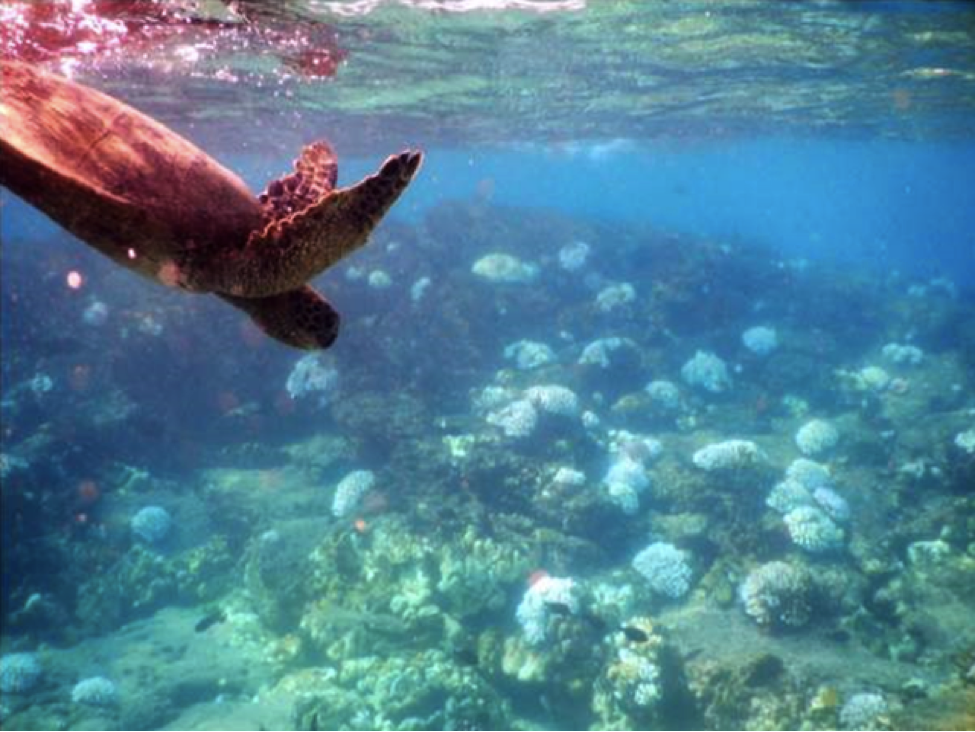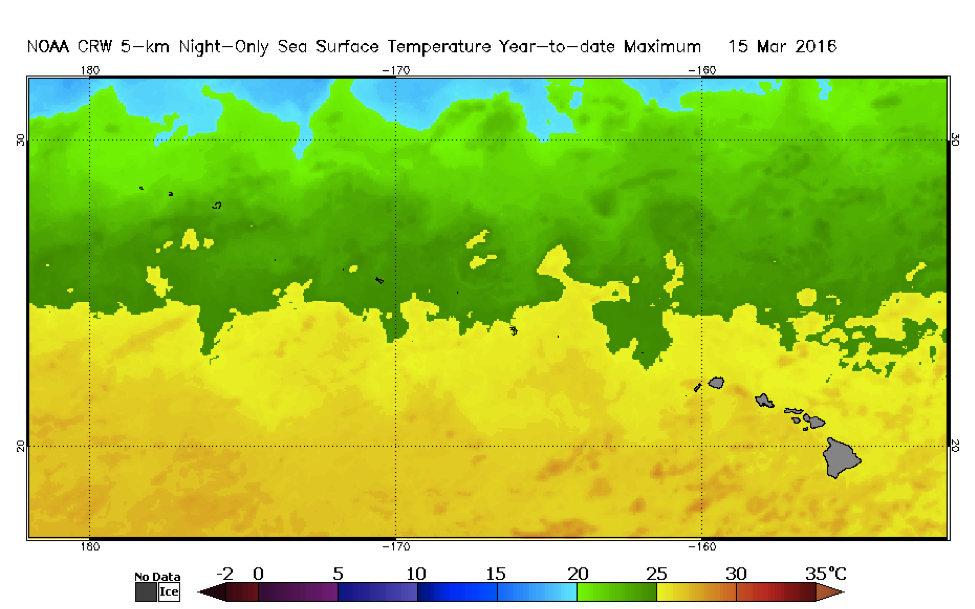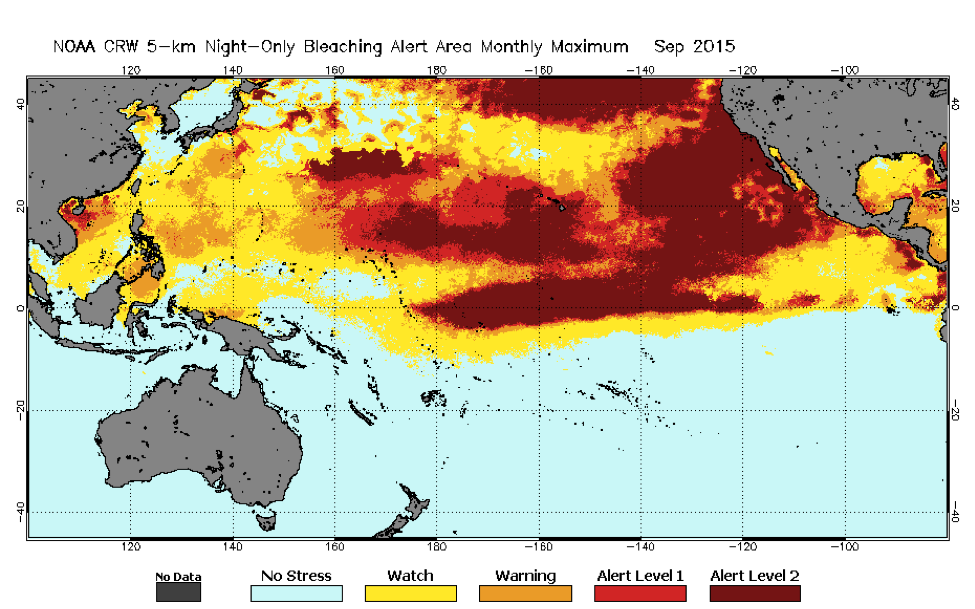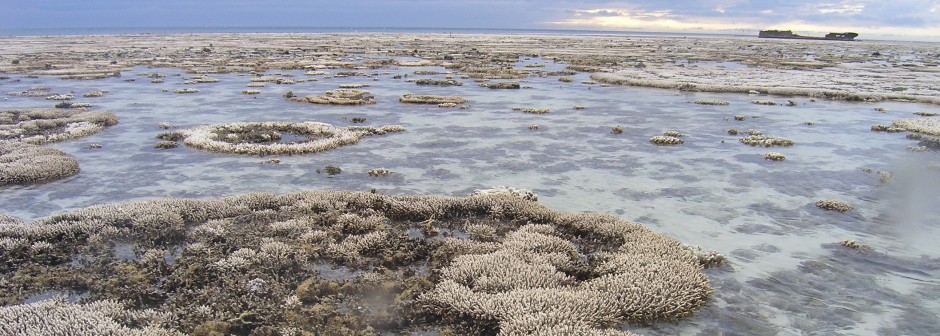In a previous post I discussed one of the largest threats facing Hawaiian reefs: coral bleaching (Figure 1). I failed, however, to go into detail about what bleaching has occurred in the past year, and what is expected to occur in the upcoming year. As a reminder, coral bleaching is when corals lose their symbiotic algae (zooxanthellae). The zooxanthellae provide the coral’s coloring, so without them the coral appear a ghostly white – hence the term “bleaching.” Coral can only live for short periods of time without zooxanthellae, and they must get back the zooxanthellae relatively quickly if they are going to survive [1].

Figure 1. A sea turtle swims over bleached cauliflower coral (Pocillopora meandrina) at Honokohau in Hawaii. Image by Lindsey Kramer
Hawaii began to see its most recent bleaching trend in the fall of 2014 [2]. At that point, scientists were worried, but most of the bleaching wasn’t fatal. During the winter, water temperatures cool, and sometimes corals are able to recover. The next widespread instance of bleaching began the next fall, in 2015. In an interview with Hawaii Tribune-Herald, Dr. Misaki Takabayashi called the bleaching “unprecedented” [3]. In October, Eyes of the Reef Hawaii, and organization for community reporting of coral health, organized “Bleachapalooza,” an event to gather data on the extent of coral bleaching all around Hawaii. Volunteers estimated bleaching and were able to report their results online [4]. As of now a final report for 2015 has not been released, but estimations for the extent of bleaching ranged from 30-80% of total coral cover [3].
So far this year, Hawaii has not had significant bleaching. Sea surface temperatures have largely stayed under 30°C, which is at the high end of tolerable for corals [1] (Figure 2).

Figure 2. Maximum sea surface temperatures (°C) in Hawaii from January 1 – March 15, 2016. Image from NOAA’s Coral Reef Watch.
Unfortunately, other reefs around the world are not getting the same relief that Hawaiian reefs are. El Niño is continuing to track warm water throughout the Pacific Ocean, which is wreaking havoc on many reefs [5]. Even more worrying is the current global temperature trend. Due to the combined effects of El Niño and climate change, February saw record-high temperatures. The average temperature for February was 1.35°C above the 1951-1980 global average for the month. It was also 0.21°C above the previous record – which was set in January. While 0.21°C may not sound like a lot, it is an incredibly large amount when speaking of global averages throughout history [6]. If this trend continues, corals will not be able to adapt fast enough to survive the warming water.
The National Oceanic and Atmospheric Administration (NOAA) monitors a website called Coral Reef Watch (http://coralreefwatch.noaa.gov/satellite/index.php), which tracks ocean conditions to predict where coral bleaching is most likely to occur [7]. Current predictions are available for March 2016 – June 2016 (Figure 3). According to these predictions, Hawaiian reefs should be able to continue to recover for a few more months. However, bleaching is expected between July and October, which is when water temperatures are highest in Hawaii. Last year in September, most of Hawaii was under Alert Level 1, which means that bleaching was likely. The parts of Hawaii that were not under Alert Level 1 were instead under Alert Level 2, which means that mortality was likely (Figure 4). Based on current trends, it seems likely that this fall will be as bad or worse for Hawaiian corals than last fall was.

Figure 3. Coral reef bleaching risk predictions for March – June 2016. Image from NOAA’s Coral Reef Watch.

Figure 4. Coral reef bleaching risk for September 2015. This fall will likely see similar trends. Image from NOAA’s Coral Reef Watch.
References:
[1] Sheppard, Charles R. C., Simon Davy, Graham Pilling. The Biology of Coral Reefs. (2009)
[2] Stallard, Brian. “Coral bleaching event: worst in decades.” Nature World News. 07 Oct. 2014.
[3] Callis, Tom. “East Hawaii Coral Bleaching ‘unprecedented’.” Hawaii Tribune-Herald. 15 Oct. 2015.
[4] “Volunteers statewide learn to spot coral bleaching.” Hawaii Department of Land and Natural Resources. 3 Oct. 2015.
[5] Ferraro, Kathleen. “Global coral ‘bleaching’ threatens reef survival.” Medill Reports Chicago. 9 Mar 2016.
[6] Masters, Jeff, Bob Henson. “February Smashes Earth’s All-Time Global Heat Record By A Jaw-Dropping Margin.” Countercurrents. 14 Mar 2016.
[7] Coral Reef Watch Satellite Monitoring. National Oceanic and Atmospheric Administration.

